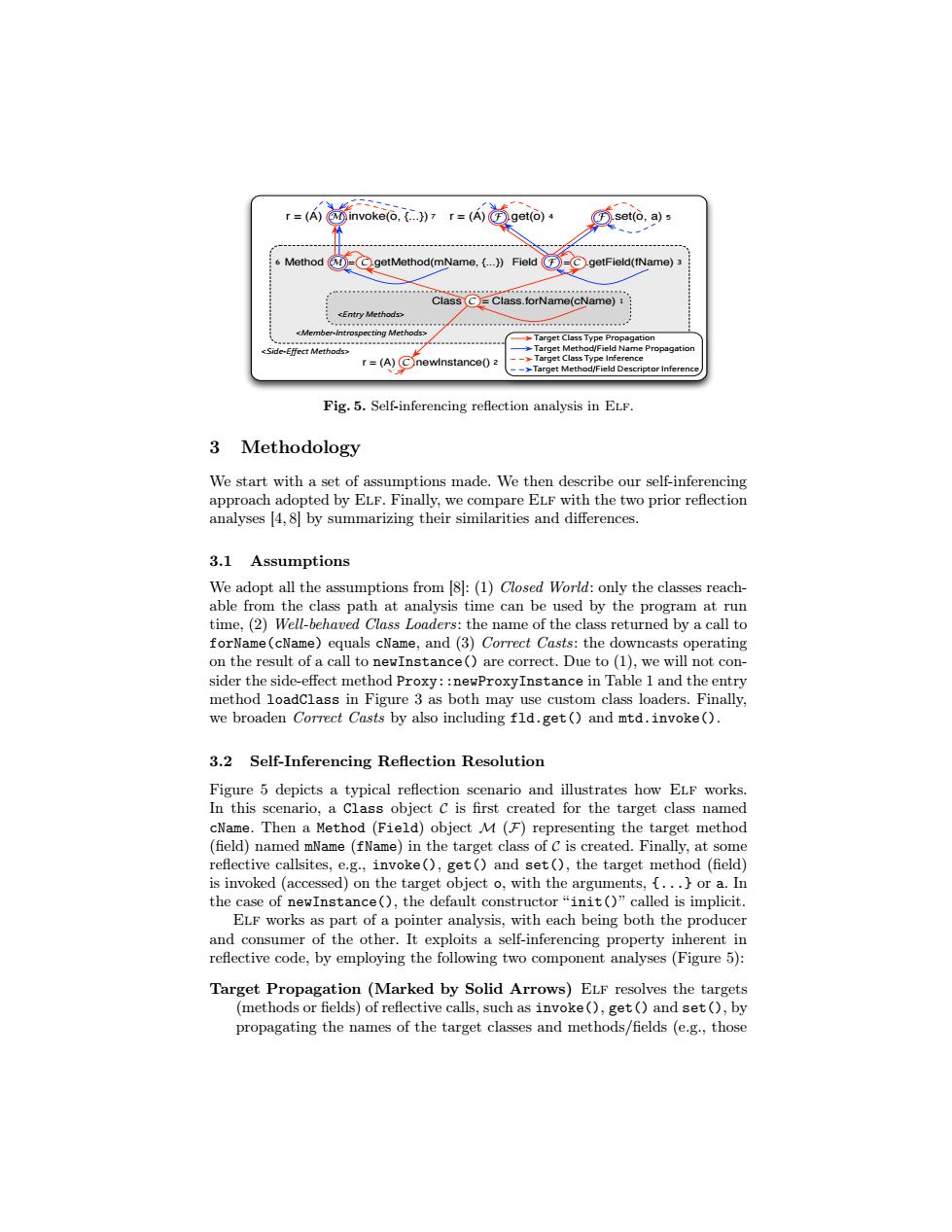正在加载图片...

r =(A)(o,{..))7 r=(A)get(o)4 ).set(o,a)s s Method M=C.getMethod(mName,{...)Field=CgetField(IName)3 Class.forName(cName)1: <Entry Methods> 年。tgw。g。w。,,。e。ee。gg。g <Member.Introspecting Methods? Target Class Type Propagation Side-Effect Methods> IName Propagation =(A)C ype ->Target Method/Field Descriptor Inference Fig.5.Self-inferencing reflection analysis in ELF. 3 Methodology We start with a set of assumptions made.We then describe our self-inferencing approach adopted by ELF.Finally,we compare ELF with the two prior reflection analyses [4,8 by summarizing their similarities and differences. 3.1 Assumptions We adopt all the assumptions from [8]:(1)Closed World:only the classes reach- able from the class path at analysis time can be used by the program at run time,(2)Well-behaved Class Loaders:the name of the class returned by a call to forName(cName)equals cName,and(3)Correct Casts:the downcasts operating on the result of a call to newInstance()are correct.Due to (1),we will not con- sider the side-effect method Proxy:newProxyInstance in Table 1 and the entry method loadClass in Figure 3 as both may use custom class loaders.Finally, we broaden Correct Casts by also including fld.get()and mtd.invoke(). 3.2 Self-Inferencing Reflection Resolution Figure 5 depicts a typical reflection scenario and illustrates how ELF works. In this scenario,a Class object C is first created for the target class named cName.Then a Method (Field)object M(F)representing the target method (field)named mName(fName)in the target class of C is created.Finally,at some reflective callsites,e.g.,invoke(),get()and set(),the target method (field) is invoked (accessed)on the target object o,with the arguments,{...or a.In the case of newInstance(),the default constructor "init()"called is implicit. ELF works as part of a pointer analysis,with each being both the producer and consumer of the other.It exploits a self-inferencing property inherent in reflective code,by employing the following two component analyses(Figure 5): Target Propagation (Marked by Solid Arrows)ELF resolves the targets (methods or fields)of reflective calls,such as invoke(),get()and set(),by propagating the names of the target classes and methods/fields (e.g.,those<Entry'Methods> <Member1Introspecting'Methods> <Side1Effect'Methods> Target'Class'Type'Propagation Target'Method/Field'Name'Propagation Target'Class'Type'Inference Target'Method/Field'Descriptor'Inference r = (A) M .invoke(o, {...}) r = (A) F .get(o) F .set(o, a) Method M = C .getMethod(mName, {...}) Class C = Class.forName(cName) Field F = C .getField(fName) r = (A) C .newInstance() 1 2 3 4 5 6 7 Fig. 5. Self-inferencing reflection analysis in Elf. 3 Methodology We start with a set of assumptions made. We then describe our self-inferencing approach adopted by Elf. Finally, we compare Elf with the two prior reflection analyses [4, 8] by summarizing their similarities and differences. 3.1 Assumptions We adopt all the assumptions from [8]: (1) Closed World: only the classes reachable from the class path at analysis time can be used by the program at run time, (2) Well-behaved Class Loaders: the name of the class returned by a call to forName(cName) equals cName, and (3) Correct Casts: the downcasts operating on the result of a call to newInstance() are correct. Due to (1), we will not consider the side-effect method Proxy::newProxyInstance in Table 1 and the entry method loadClass in Figure 3 as both may use custom class loaders. Finally, we broaden Correct Casts by also including fld.get() and mtd.invoke(). 3.2 Self-Inferencing Reflection Resolution Figure 5 depicts a typical reflection scenario and illustrates how Elf works. In this scenario, a Class object C is first created for the target class named cName. Then a Method (Field) object M (F) representing the target method (field) named mName (fName) in the target class of C is created. Finally, at some reflective callsites, e.g., invoke(), get() and set(), the target method (field) is invoked (accessed) on the target object o, with the arguments, {...} or a. In the case of newInstance(), the default constructor “init()” called is implicit. Elf works as part of a pointer analysis, with each being both the producer and consumer of the other. It exploits a self-inferencing property inherent in reflective code, by employing the following two component analyses (Figure 5): Target Propagation (Marked by Solid Arrows) Elf resolves the targets (methods or fields) of reflective calls, such as invoke(), get() and set(), by propagating the names of the target classes and methods/fields (e.g., those